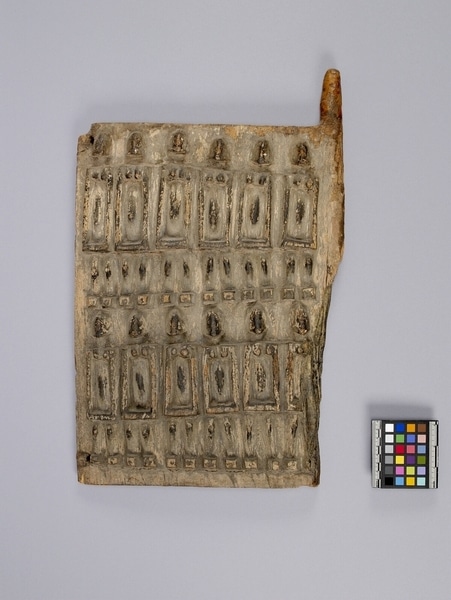Granary Door Item Number: Ag70 from the MOA: University of British Columbia

Description
Rectangular wooden granary door or shutter, with two rows of stylized figures carved in relief on front. Peg-like protrusion from one upper corner.
History Of Use
Dogon granaries are narrow mud-bricked structures with thatched-roofs that store millet sorghum rice, corn, fonio, beans and other staples. Speaking poorly of the millet is believed to cause the millet crop to disappear, or "walk off". In Dogon myth, Ogo steals seeds from Amma, the Almighty, which is akin to the "Original Sin". Therefore, the Dogon place a high importance on keeping and storing grains safely. There are several granaries for each family, and the shutters are either placed as doors or windows. Traditionally, they are placed two thirds up the north wall of the granary. Some shutters are additionally used on Binu sanctuaries; the Binu are immortal beings who are seen as a source of power and protection for each Dogon clan. The Binu spirits are said to commonly reveal themselves to their descendants by contacting them through the form of an animal during a clan's founding or migration. The Dogon appeal to the Binu for prosperity, fertility, rain, and an abundant crop.
Iconographic Meaning
Dogon attach a strong link between fertility and cultivating crops, so the female carvings are likely a physical representation of this link. They could also represent the emme ya, a female sorghum that represents life, nutritious food, and purity. The construction method, of having two planks, symbolizes how man and grain were created together in order to work the earth.
Item History
- Made in Mopti, Mali
- Owned by Eric Sonner before October 22, 1990
- Received from Eric Sonner (Donor) on October 22, 1990
What
Who
- Culture
- Dogon
- Previous Owner
- Eric Sonner
- Received from
- Eric Sonner (Donor)
Where
- Holding Institution
- MOA: University of British Columbia
- Made in
- Mopti, Mali
When
- Ownership Date
- before October 22, 1990
- Acquisition Date
- on October 22, 1990
Other
- Condition
- fair
- Accession Number
- 1433/0053